
The Adonis blue is a butterfly in the family Lycaenidae. It inhabits the Palearctic realm.

Coenonympha tullia, the large heath or common ringlet, is a butterfly in the family Nymphalidae. It flies in a variety of grassy habitats, including roadsides, woodland edges and clearings, prairies, bogs, and arctic and alpine taiga and tundra. It is a poor flyer, but can sometimes be found along ditches seeking new grounds. It is a holarctic species found in northern Europe, east across the Palearctic and across North America. The species was first described by Otto Friedrich Müller in 1764.

The purple-shot copper is a butterfly in the family of the Lycaenidae or copper butterflies and in the genus of the Lycaena.

The scarce copper is a butterfly of the family Lycaenidae.

The purple-edged copper is a butterfly of the family Lycaenidae.
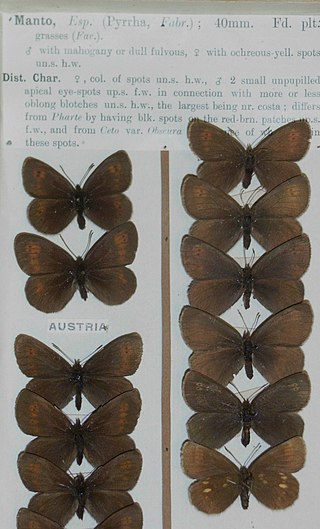
The yellow-spotted ringlet is a member of the subfamily Satyrinae of the family Nymphalidae. It is associated with (sub)alpine meadows at 900–2,500 m above sea level. It is found in the Alps, the Pyrenees, the Cantabrian Mountains, the Massif Central, the Vosges Mountains, the Carpathian Mountains and the mountains of Herzegovina.
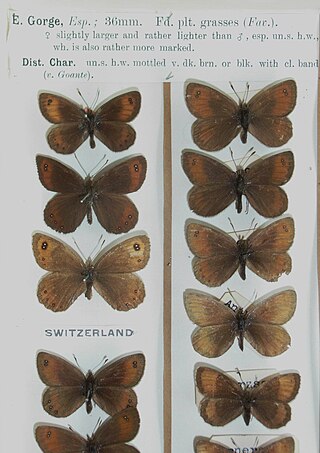
The silky ringlet is a member of the subfamily Satyrinae of the family Nymphalidae. It is a high-altitude butterfly found on screes in the Alps, Pyrenees, central Italy and the Balkans. It is a very variable butterfly.

The marbled ringlet is a member of the subfamily Satyrinae of the family Nymphalidae.

The Styrian ringlet is a member of the subfamily Satyrinae of the family Nymphalidae. It is a mountain butterfly found in the Austrian and Italian Alps, Croatia and Slovenia.

The water ringlet is a member of the subfamily Satyrinae of family Nymphalidae. It is a high altitude butterfly found in the Alps, Bavaria, Styria, Pyrenees, Carpathians and Bulgaria.

Glaucopsyche alexis, the green-underside blue, is a butterfly of the family Lycaenidae. It is found in the Palearctic.
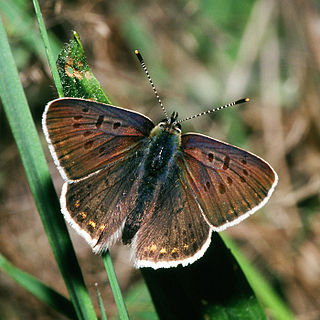
Lycaena tityrus, the sooty copper, is a butterfly of the family Lycaenidae. It is found in Europe.

Aricia nicias, the silvery argus, is a butterfly of the family Lycaenidae. It is found in the Alps, Pyrenees and from Scandinavia ranging to Siberia and the north of Mongolia.

Pseudophilotes baton, the baton blue, is a butterfly of the family Lycaenidae. It is found in central and southern Europe and then east across the Palearctic to the Russian Far East.

Polyommatus damon, the Damon blue, is a butterfly of the family Lycaenidae.

Polyommatus escheri, Escher's blue, is a butterfly of the family Lycaenidae. It is found in Southern Europe and Morocco.

Erebia pandrose, the dewy ringlet, is a member of the subfamily Satyrinae of the family Nymphalidae. It is found from the Arctic areas of northern Europe, the Pyrenees, Alps, the Apennine Mountains, the Carpathian Mountains, Kola Peninsula and Kanin Peninsula, part of the Ural and the Altai and Sayan Mountains up to Mongolia.
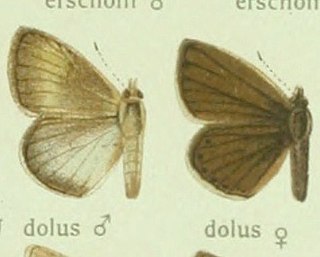
Polyommatus dolus, the furry blue, is a butterfly of the family Lycaenidae. It is found in Spain, in France and Italy.
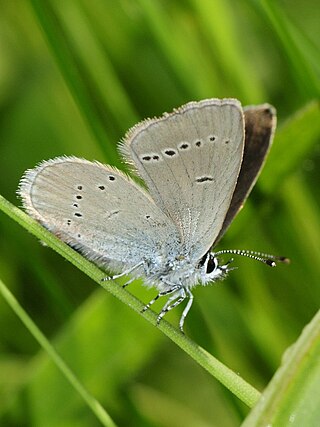
The Osiris blue is a butterfly in the family Lycaenidae. It is found in South Europe, Asia Minor, southern Siberia, the Alay Mountains, Tian-Shan, Dzhungarsky Alatau, the Altai Region, the Sayan mountains, Lake Baikal and Mongolia. It is often confused with the small blue, a closely related species.
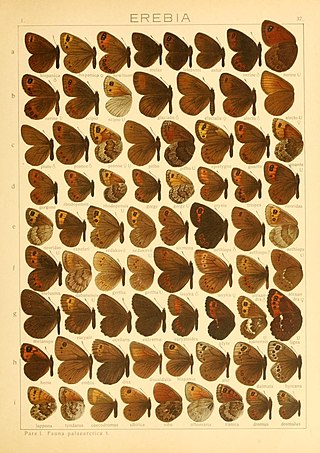
Erebia dabanensis is a small butterfly found in the East Palearctic that belongs to the browns family.

























